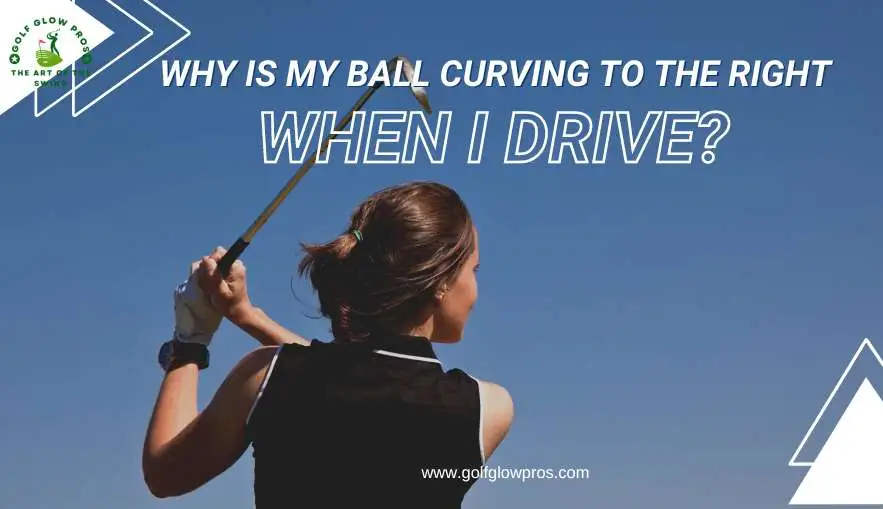Why Does My Golf Ball Curve Left? Read full for details, When the club face is to the left of the swing path, the golf ball curves left. The ball will curve away from the swing path due to a basic ball flight law.
If your club face is to the right of the target line, for example, the ball will continue to curve left even if your swing path is further to the right.
Alternatively, if your clubface is to the left of the target line, the swing path will start there and curve to the left.
First and foremost, your grip could be to blame. Additionally, if your grip is too strong, with both hands turned too far to the right on the handle, the ball will veer left.
Let’s talk about your swing path now. You’re more likely to see that leftward curve if you swing from outside to inside, which means the clubhead approaches the ball from the right and then crosses over the target line.
Your clubface alignment could also be to blame. If your clubface is closed (pointing left) at impact, the ball will be steered that way.
Consider your position as well. Additionally, if your feet, hips, or shoulders are aligned to the left of the target, it can affect the path of the ball.
Wind can also play a role. If the wind is blowing from right to left, the ball’s movement to the left may be exaggerated.
Finally, double-check your equipment. A club with excessive loft or a shaft with excessive flexibility may contribute to the leftward curve.
Finally, don’t let that leftward curve drive you insane. Examine your grip, swing path, clubface alignment, stance, wind conditions, and equipment to determine the source of the problem and work toward a straighter shot. Have a great time golfing!
What Causes the Ball to Curve?
When you hit a golf ball, several factors influence its trajectory. To begin with, your swing – the way you hit the ball – influences a great deal. The ball can veer off course if your clubface isn’t square at impact.
Consider your grip right now. A good grip helps you hit a straight shot, but a bad grip can cause the ball to curve unexpectedly. Take note of how you’re holding that club.
Additionally, the ball’s spin is important. If it’s spinning in one direction, it’ll curve in the same direction. Consider it like a car turning, with the spin acting as steering golf ball curve left.
Wind is an additional player in this game. Furthermore, a strong breeze can catch the ball in mid-flight and change its path. Additionally, it’s like trying to walk straight in a strong wind – impossible!
Finally, the terrain is important. A slope or uneven ground can cause the ball to deviate from its intended path. Moreover, it’s golf’s equivalent of a winding road.
In summary, your swing, grip, spin, wind, and terrain all work together to determine whether your ball goes straight or curves. So, keep practicing your swing and paying attention to these factors for a more enjoyable time on the golf course!
What is it Called When A Golf Ball Curves to the Left?
Have you ever seen a golf ball swerve to the left in mid-flight? That’s called a “hook” in golf. Consider this: you take a swing, and instead of going straight, the ball turns to the left. It’s like the golf course rebel who refuses to take the expected path.
Let’s break it down now. Additionally, a hooking golf ball means it is curving to the left for a right-handed player. Conversely, it’s the opposite for lefties; your hook swings to the right. Furthermore, it’s as if the ball has its own mind, deciding to dance to the left.
So, what causes this? It’s usually due to the way the clubface makes contact with the ball. If it’s too close, however, the ball declares, “I’m going left!” It’s similar to a rebellious adolescent going against the grain.
Don’t mix up a hook and a slice; they’re golf cousins, but not twins. When a right-handed golfer strikes a slice, the ball curves to the right. Hooks and slices act as golf’s yin and yang, balancing each other out on the course.
A hook is when your golf ball takes an unexpected left turn, adding a touch of unpredictability to your game. So, the next time your ball hooks, remember that it’s doing its own little leftward dance on the green.
How Do I Stop My Golf Ball from Going Left?
Okay, let’s correct your golf ball’s leftward drift. First, examine your grip. Hold the club firmly, but not as if you’re wrestling. Make sure your stance is square, with your feet shoulder-width apart and parallel to the target.
Next, check your alignment. Moreover, check that your feet, hips, and shoulders are pointing in the desired direction for the ball. Alignment is similar to programming your shot’s GPS.
Keep an eye on the position of the ball. Additionally, it should be parallel to your front heel, not your back. This assists in striking the ball straight and true golf ball curve left.

The swing makes it simple. Moreover, don’t go Herculean on it. Additionally, the golf game is won by being smooth and steady. Furthermore, swing with controlled power after taking a deep breath.
Keep an eye out for the clubface. Additionally, check that it is not closed. If it’s facing left, the ball is moving to the left. Square up as if you were shaking hands with the target.
Finally, proceed as if you were waving to a friend. After impact, keep that club on the target line. A good follow-through ensures a successful shot.
How Do You Hit A Golf Ball Left to Right?
Aim your feet, hips, and shoulders slightly to the left; this makes the golf ball travel from left to right. This lays the groundwork for a right-to-left shot.
Relax your grip on the club to make a smoother swing. Additionally, begin your backswing low and slow, keeping a smooth tempo. As you swing back, shift your weight to the right side.
“Now, as you swing through, concentrate on getting the club from inside to outside. Additionally, consider moving the ball to the right. Moreover, at impact, keep your hands ahead of the clubhead to promote a controlled fade.”
Follow through by rotating your body so that your chest faces the target. Finish with your weight balanced and confidently on your left side.
To develop a consistent left-to-right shot, practice this movement on the driving range. Additionally, experiment with different grips, stances, and swing tempos to see what works best for you. With time and practice, you’ll master the art of hitting a golf ball left to right.
How Do I Make My Golf Ball Not Curve?
1. Grip it Right
Use a firm but comfortable grip on your club. This lays the groundwork for a straight shot.
2. Stance Matters
Place your feet shoulder-width apart. A balanced stance assists you in controlling the direction of your swing.
3. Align the Clubface
Check that the clubface is parallel to the target. This reduces the likelihood of the ball deviating from its intended path.
4. Keep Your Eye on the Ball
Concentrate on the ball not only during the swing, but also before and after. It aids in maintaining a consistent shot.
5. Smooth Swings Rule
Avoid abrupt jerks. Swing steadily and smoothly. Unwanted spins can result from jerky movements.
6. Practice Regularly
Repetition is essential. Spend time on the range to improve your technique and muscle memory, resulting in a more accurate shot.
7. Choose the Right Ball
The flight characteristics of different balls vary. Choose one that complements your swing and playing style.

8. Consider Lessons
Take golf lessons from a pro if possible. They can provide you with tailored advice on how to improve your swing and reduce unwanted curves.
9. Stay Relaxed
Tension in your body can affect your swing. Maintain a relaxed posture, particularly in your hands and arms.
10. Adjust Your Grip if Needed
If you notice persistent curves, experiment with your grip. A small change can sometimes make a significant difference.
How Do You Control the Direction Of A Golf Ball?
The ability to control the direction of a golf ball is critical for making a successful shot. To begin, take a comfortable but firm grip on the club. This gives you complete control over the clubface. After that, line up your feet and shoulders parallel to the target. This lays the groundwork for a straight shot.
Now, concentrate on your stance. Maintain an even distribution of your weight on both feet. This aids in maintaining balance during your swing.
Turn your shoulders smoothly as you begin your backswing. This motion helps to generate power for the shot.
Take note of your club face. At impact, ensure that it is square to the target. A closed or open face may cause the ball to curve in flight.
Throughout the swing, keep your gaze fixed on the ball. This increases the precision and consistency of the golf ball curve left.
Take a look at the club path. A swing that follows an inside-out path produces a draw, whereas one that follows an outside-in path produces a fade. Experiment with these routes to see which one works best for you. Regular practice will help you build muscle memory and improve your control.
How Do You Hit A Straight Shot in Golf or Why Does My Golf Ball Curve Left?
To begin, position your feet shoulder-width apart. This creates a solid foundation.
After that, aim the clubface directly at your target. Take a moment to ensure that everything is correct.
Now, take a comfortable grip on the club, not too tight or too loose. Finding that sweet spot is critical.
Keep your body square to the target as you address the ball. Additionally, this prepares the ground for a straight shot.
Maintain a natural rhythm on your backswing. Additionally, there is no reason to rush through this section.
When transitioning to the downswing, keep your arms relaxed. Tension can cause undesirable curves.
As you swing, keep your gaze fixed on the ball. It aids in maintaining precision.
Finally, finish with a balanced finish. Consider it a graceful dance move – smooth and controlled.
Always remember that practice makes perfect. Spend some time at the range practicing these techniques. Straight shots will become second nature to you before you know it.
Why is My Ball Curving to the Right When I Drive?
Firstly, analyze your grip. Additionally, relax your grip if it resembles a death grip. A tight grip can cause the clubface to close, subsequently sending the ball to the right.
Following that, your stance is important. Check that your feet are aligned with the target and not off to the right. Additionally, a skewed stance can result in an unintended slice.
Concentrate on your swing path now. A slice is frequently the result of an outside-to-inside swing. For a more accurate shot, try swinging straighter through the ball golf ball curve left.
Moreover, think about your clubface position at impact. When it’s open, the ball tends to go right. To get a straighter shot, first, adjust the face angle to make a square impact. Additionally, ensure proper alignment with the target for better accuracy.

Additionally, do not forget about your shoulders. Furthermore, check that they’re parallel to the target. Shoulder misalignment can contribute to that pesky rightward curve.
Finally, pay attention to your follow-through. A premature stop can devastate your shot. Therefore, maintain a smooth follow-through to keep the ball in play.
How Do You Drive A Golf Ball Straight Every Time?
To consistently hit a golf ball straight, start with a balanced stance. Align your feet shoulder-width apart and with the target.
Next, take a light yet firm grip on the club. Additionally, squeezing too tightly can interfere with your swing.
Furthermore, place the ball in line with your lead heel, not too far forward or backward.
Maintain your gaze on a point just behind the ball throughout your swing. This aids in maintaining proper head position golf ball curve left.
Additionally, backswing smoothly, ensuring your arms and body remain in sync. Overswinging should be avoided because it can result in inconsistent shots.
Swing down, shifting your weight from your back foot to your front foot. This encourages a strong impact with the ball.
Allow the clubface to naturally square up by rotating your hips and shoulders throughout the shot golf ball curve left.
Maintain a calm and balanced follow-through. A more fluid finish leads to a straighter shot.
Regular practice will help you improve muscle memory and swing consistency. I think you clear about Why Does My Golf Ball Curve Left.












